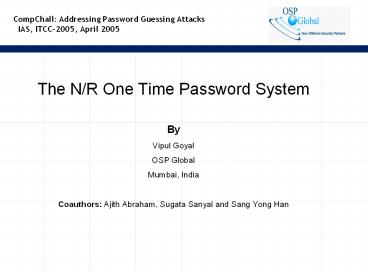CompChall: Addressing Password Guessing Attacks IAS, ITCC-2005, April 2005
1 / 17
Title:
CompChall: Addressing Password Guessing Attacks IAS, ITCC-2005, April 2005
Description:
Title: Resume Author: Kishor Vaswani Last modified by: Vipul Goyal Created Date: 2/18/1998 3:18:56 PM Document presentation format: On-screen Show Other titles –
Number of Views:103
Avg rating:3.0/5.0
Title: CompChall: Addressing Password Guessing Attacks IAS, ITCC-2005, April 2005
1
CompChall Addressing Password Guessing Attacks
IAS, ITCC-2005, April 2005
- The N/R One Time Password System
- By
- Vipul Goyal
- OSP Global
- Mumbai, India
- Coauthors Ajith Abraham, Sugata Sanyal and Sang
Yong Han
2
CompChall Addressing Password Guessing Attacks
IAS, ITCC-2005, April 2005
- Introduction
- Authentication for mobile devices needs to be
efficient and low cost - Needs to prevent against two major attacks
eavesdropping and server compromise
3
CompChall Addressing Password Guessing Attacks
IAS, ITCC-2005, April 2005
- Introduction contd ..
- Lamport used just one way hash functions to
design a very efficient authentication scheme
called one time passwords (OTP) - Interestingly, it is secure against both
eavesdropping and server compromise without using
public key cryptography - The only scheme of its type
4
CompChall Addressing Password Guessing Attacks
IAS, ITCC-2005, April 2005
- One time passwords
- Setup phase recursively hash the password n
times to obtain a hash chain tip T - T h(h(.h(p))) (also denoted as hn(p) )
- The server stores T and client stores the
password p - No need to keep T secret
- n represents the number of times the client may
login
5
CompChall Addressing Password Guessing Attacks
IAS, ITCC-2005, April 2005
- One time passwords contd..
- Operation Phase For the i th authentication,
user computes hn-i(p) and sends to the server as
a one time password - Server hashes the received OTP and matches with
the one stored in its own database (which would
be the last OTP sent) - Match signifies success, server replaces the OTP
in its database with the received one
6
CompChall Addressing Password Guessing Attacks
IAS, ITCC-2005, April 2005
- One time passwords contd..
- OTPs are secure because of non-invertiblity of
the hash function used - Impossible to compute the next OTP by knowing all
the previously used OTPs
7
CompChall Addressing Password Guessing Attacks
IAS, ITCC-2005, April 2005
- Problems with OTPs
- Computation might be prohibitive for mobile
devices as its computation requires n/2 hash
function evaluations on an average - System re-initialization required after n
authentications - n cannot be made very large due to computational
requirements
8
CompChall Addressing Password Guessing Attacks
IAS, ITCC-2005, April 2005
- Our system
- Basic idea is to have the server aid the client
computation by sending a value whenever it
attempts to login - Uses a new construction of hash chains in which,
a breakpoint is inserted after a fixed number
of links - The server stores the links on which the
breakpoint is inserted, one of these links is
passed to client at the login time to aid
computation
9
CompChall Addressing Password Guessing Attacks
IAS, ITCC-2005, April 2005
- System overview
- Denote with N the number of times a user may
login. This is equal to the length of the hash
chain - R is the server storage required
- N/R will be the maximum number of hash function
evaluations required by the client (in contrast
to N in OTPs0 - Average number of hash operations will be N/2R
10
CompChall Addressing Password Guessing Attacks
IAS, ITCC-2005, April 2005
- Simplified system description
- First define a function ?x(p) using the following
recurrence relation - ?k1(p) h(?k(p) dp)
- where d 1 for k i(N-NR)/R
- 0 for k ? i(N-NR)/R
- and, ?0(p) p
11
CompChall Addressing Password Guessing Attacks
IAS, ITCC-2005, April 2005
- System description contd ..
- Consider links where d 1
- Password knowledge will be required to find
?k1(p) from ?k(p) for such links - Note that it is never possible to compute ?k-1(p)
from ?k(p) - Thus, links with d 1 are not security sensitive
12
CompChall Addressing Password Guessing Attacks
IAS, ITCC-2005, April 2005
- System setup
- Client computes the hash chain using the formula
given (i.e. computes ?N(p) ) - Server stores the tip ?N(p) as well as all
non-security sensitive links - No secrets stored at the server
13
CompChall Addressing Password Guessing Attacks
IAS, ITCC-2005, April 2005
- System operation (for tth login)
- Client identifies himself
- Server sends (n , ?k(p))
- where n (N-t)R with n ? 0 and k N-t-n
- Client simply computes ?kn(p) and sends it back
as the OTP - ?kn(p) hn(?k(p) p)
14
CompChall Addressing Password Guessing Attacks
IAS, ITCC-2005, April 2005
- System operation contd ..
- Server hashes the received OTP and matches it
with the last one stored in its database - In case of success, server overwrites the last
OTP with that received - Value of t is incremented
15
CompChall Addressing Password Guessing Attacks
IAS, ITCC-2005, April 2005
- Protocol figure
16
CompChall Addressing Password Guessing Attacks
IAS, ITCC-2005, April 2005
- Comparison
- Host computation decreases by a factor of R at
the cost of increasing the server storage by the
same factor. Hence value of R is a system
tradeoff. - Server computation remains the same
- Protocol is more practical for mobile devices and
it becomes possible to choose a high value of N
17
CompChall Addressing Password Guessing Attacks
IAS, ITCC-2005, April 2005
- Thank You































